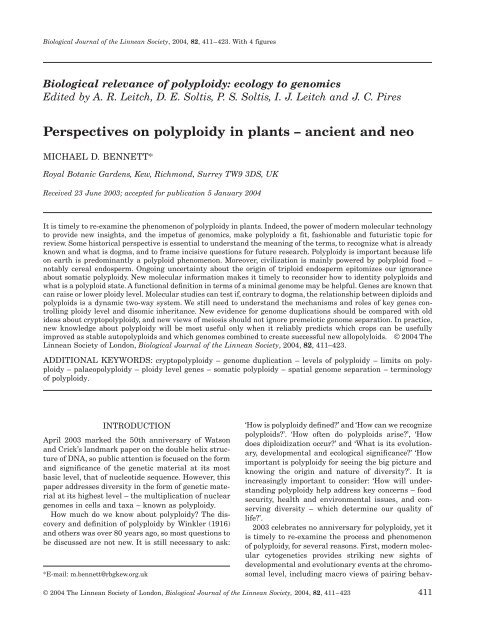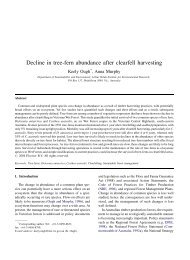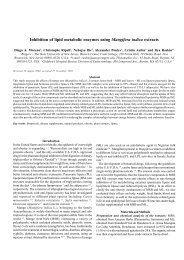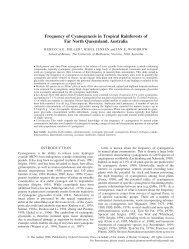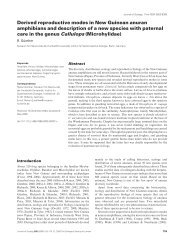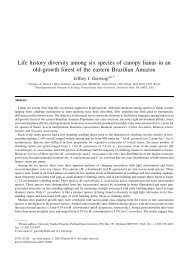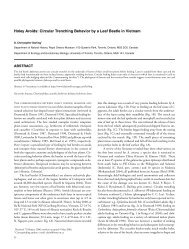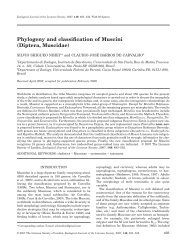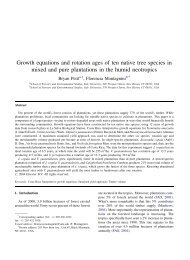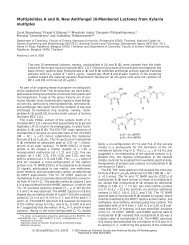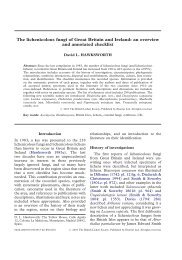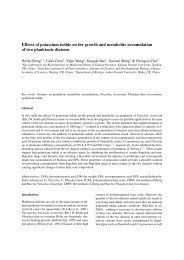Perspectives on polyploidy in plants – ancient and neo
Perspectives on polyploidy in plants – ancient and neo
Perspectives on polyploidy in plants – ancient and neo
You also want an ePaper? Increase the reach of your titles
YUMPU automatically turns print PDFs into web optimized ePapers that Google loves.
Blackwell Science, LtdOxford, UKBIJBiological Journal of the L<strong>in</strong>nean Society0024-4066The L<strong>in</strong>nean Society of L<strong>on</strong>d<strong>on</strong>, 2004? 2004<br />
824<br />
411423<br />
Review Article<br />
PERSPECTIVES ON POLYPLOIDY<br />
M. D. BENNETT<br />
Biological Journal of the L<strong>in</strong>nean Society, 2004, 82, 411<strong>–</strong>423. With 4 figures<br />
Biological relevance of <strong>polyploidy</strong>: ecology to genomics<br />
Edited by A. R. Leitch, D. E. Soltis, P. S. Soltis, I. J. Leitch <strong>and</strong> J. C. Pires<br />
<str<strong>on</strong>g>Perspectives</str<strong>on</strong>g> <strong>on</strong> <strong>polyploidy</strong> <strong>in</strong> <strong>plants</strong> <strong>–</strong> <strong>ancient</strong> <strong>and</strong> <strong>neo</strong><br />
MICHAEL D. BENNETT*<br />
Royal Botanic Gardens, Kew, Richm<strong>on</strong>d, Surrey TW9 3DS, UK<br />
Received 23 June 2003; accepted for publicati<strong>on</strong> 5 January 2004<br />
It is timely to re-exam<strong>in</strong>e the phenomen<strong>on</strong> of <strong>polyploidy</strong> <strong>in</strong> <strong>plants</strong>. Indeed, the power of modern molecular technology<br />
to provide new <strong>in</strong>sights, <strong>and</strong> the impetus of genomics, make <strong>polyploidy</strong> a fit, fashi<strong>on</strong>able <strong>and</strong> futuristic topic for<br />
review. Some historical perspective is essential to underst<strong>and</strong> the mean<strong>in</strong>g of the terms, to recognize what is already<br />
known <strong>and</strong> what is dogma, <strong>and</strong> to frame <strong>in</strong>cisive questi<strong>on</strong>s for future research. Polyploidy is important because life<br />
<strong>on</strong> earth is predom<strong>in</strong>antly a polyploid phenomen<strong>on</strong>. Moreover, civilizati<strong>on</strong> is ma<strong>in</strong>ly powered by polyploid food <strong>–</strong><br />
notably cereal endosperm. Ongo<strong>in</strong>g uncerta<strong>in</strong>ty about the orig<strong>in</strong> of triploid endosperm epitomizes our ignorance<br />
about somatic <strong>polyploidy</strong>. New molecular <strong>in</strong>formati<strong>on</strong> makes it timely to rec<strong>on</strong>sider how to identity polyploids <strong>and</strong><br />
what is a polyploid state. A functi<strong>on</strong>al def<strong>in</strong>iti<strong>on</strong> <strong>in</strong> terms of a m<strong>in</strong>imal genome may be helpful. Genes are known that<br />
can raise or lower ploidy level. Molecular studies can test if, c<strong>on</strong>trary to dogma, the relati<strong>on</strong>ship between diploids <strong>and</strong><br />
polyploids is a dynamic two-way system. We still need to underst<strong>and</strong> the mechanisms <strong>and</strong> roles of key genes c<strong>on</strong>troll<strong>in</strong>g<br />
ploidy level <strong>and</strong> disomic <strong>in</strong>heritance. New evidence for genome duplicati<strong>on</strong>s should be compared with old<br />
ideas about crypto<strong>polyploidy</strong>, <strong>and</strong> new views of meiosis should not ignore premeiotic genome separati<strong>on</strong>. In practice,<br />
new knowledge about <strong>polyploidy</strong> will be most useful <strong>on</strong>ly when it reliably predicts which crops can be usefully<br />
improved as stable autopolyploids <strong>and</strong> which genomes comb<strong>in</strong>ed to create successful new allopolyloids. © 2004 The<br />
L<strong>in</strong>nean Society of L<strong>on</strong>d<strong>on</strong>, Biological Journal of the L<strong>in</strong>nean Society, 2004, 82, 411<strong>–</strong>423.<br />
ADDITIONAL KEYWORDS: crypto<strong>polyploidy</strong> <strong>–</strong> genome duplicati<strong>on</strong> <strong>–</strong> levels of <strong>polyploidy</strong> <strong>–</strong> limits <strong>on</strong> <strong>polyploidy</strong><br />
<strong>–</strong> palaeo<strong>polyploidy</strong> <strong>–</strong> ploidy level genes <strong>–</strong> somatic <strong>polyploidy</strong> <strong>–</strong> spatial genome separati<strong>on</strong> <strong>–</strong> term<strong>in</strong>ology<br />
of <strong>polyploidy</strong>.<br />
INTRODUCTION<br />
April 2003 marked the 50th anniversary of Wats<strong>on</strong><br />
<strong>and</strong> Crick’s l<strong>and</strong>mark paper <strong>on</strong> the double helix structure<br />
of DNA, so public attenti<strong>on</strong> is focused <strong>on</strong> the form<br />
<strong>and</strong> significance of the genetic material at its most<br />
basic level, that of nucleotide sequence. However, this<br />
paper addresses diversity <strong>in</strong> the form of genetic material<br />
at its highest level <strong>–</strong> the multiplicati<strong>on</strong> of nuclear<br />
genomes <strong>in</strong> cells <strong>and</strong> taxa <strong>–</strong> known as <strong>polyploidy</strong>.<br />
How much do we know about <strong>polyploidy</strong>? The discovery<br />
<strong>and</strong> def<strong>in</strong>iti<strong>on</strong> of <strong>polyploidy</strong> by W<strong>in</strong>kler (1916)<br />
<strong>and</strong> others was over 80 years ago, so most questi<strong>on</strong>s to<br />
be discussed are not new. It is still necessary to ask:<br />
*E-mail: m.bennett@rbgkew.org.uk<br />
‘How is <strong>polyploidy</strong> def<strong>in</strong>ed?’ <strong>and</strong> ‘How can we recognize<br />
polyploids?’. ‘How often do polyploids arise?’, ‘How<br />
does diploidizati<strong>on</strong> occur?’ <strong>and</strong> ‘What is its evoluti<strong>on</strong>ary,<br />
developmental <strong>and</strong> ecological significance?’ ‘How<br />
important is <strong>polyploidy</strong> for see<strong>in</strong>g the big picture <strong>and</strong><br />
know<strong>in</strong>g the orig<strong>in</strong> <strong>and</strong> nature of diversity?’. It is<br />
<strong>in</strong>creas<strong>in</strong>gly important to c<strong>on</strong>sider: ‘How will underst<strong>and</strong><strong>in</strong>g<br />
<strong>polyploidy</strong> help address key c<strong>on</strong>cerns <strong>–</strong> food<br />
security, health <strong>and</strong> envir<strong>on</strong>mental issues, <strong>and</strong> c<strong>on</strong>serv<strong>in</strong>g<br />
diversity <strong>–</strong> which determ<strong>in</strong>e our quality of<br />
life?’.<br />
2003 celebrates no anniversary for <strong>polyploidy</strong>, yet it<br />
is timely to re-exam<strong>in</strong>e the process <strong>and</strong> phenomen<strong>on</strong><br />
of <strong>polyploidy</strong>, for several reas<strong>on</strong>s. First, modern molecular<br />
cytogenetics provides strik<strong>in</strong>g new sights of<br />
developmental <strong>and</strong> evoluti<strong>on</strong>ary events at the chromosomal<br />
level, <strong>in</strong>clud<strong>in</strong>g macro views of pair<strong>in</strong>g behav-<br />
© 2004 The L<strong>in</strong>nean Society of L<strong>on</strong>d<strong>on</strong>, Biological Journal of the L<strong>in</strong>nean Society, 2004, 82, 411<strong>–</strong>423 411
412 M. D. BENNETT<br />
iour, <strong>and</strong> of genome orig<strong>in</strong>s <strong>and</strong> reorganizati<strong>on</strong>. For<br />
example (Fig. 1A), allotetraploid Nicotiana tabaccum<br />
(2n = 4x = 48) probed with genomic DNA from<br />
N. sylvestris clearly shows both its allotetraploid orig<strong>in</strong><br />
<strong>and</strong> reveals numerous rearrangements between S<br />
<strong>and</strong> T genome chromosomes (Kent<strong>on</strong> et al., 1993; Lim<br />
et al., 2004 <strong>–</strong> this issue). Interest<strong>in</strong>gly, prob<strong>in</strong>g Sorghum<br />
bicolor (2n = 20) with a BAC probe from Sorghum<br />
shows two subsets of five chromosomes,<br />
labell<strong>in</strong>g centromeric regi<strong>on</strong>s <strong>on</strong> <strong>on</strong>e but not the other<br />
(Fig. 1B), c<strong>on</strong>sistent with an allotetraploid nature<br />
(Gómez et al., 1998).<br />
Sec<strong>on</strong>d, comparative DNA analyses of complete<br />
genome sequences or synteny reveal massive duplicati<strong>on</strong>s<br />
<strong>in</strong> many species traditi<strong>on</strong>ally viewed as classical<br />
diploids show<strong>in</strong>g that they are actually cryptic or<br />
palaeopolyploids (Lukens et al., 2004 <strong>–</strong> this issue).<br />
Figure two <strong>in</strong> the l<strong>and</strong>mark paper <strong>on</strong> the first complete<br />
plant genome sequence (Arabidopsis Genome<br />
Initiative, 2000) showed the surpris<strong>in</strong>g f<strong>in</strong>d<strong>in</strong>g that<br />
most of the Arabidopsis thaliana genome comprises<br />
duplicated segments. With its t<strong>in</strong>y DNA C-value, <strong>and</strong><br />
<strong>on</strong>ly five l<strong>in</strong>kage groups, A. thaliana (2n = 10) was<br />
regarded as a classical diploid. Yet analysis of its DNA<br />
sequences shows its nuclear genome may be the product<br />
of three (Bowers et al., 2003; Kellogg, 2003) or four<br />
(Visi<strong>on</strong>, Brown & Tanksley, 2000) <strong>ancient</strong> rounds of<br />
genome duplicati<strong>on</strong>, whilst yet another recent round<br />
of polyploidizati<strong>on</strong> produced its <strong>neo</strong>-tetraploid relatives<br />
such as Arabidopsis suecica (2n = 26) (Tut<strong>in</strong><br />
et al., 1993).<br />
This new ability to detect duplicati<strong>on</strong>s is not c<strong>on</strong>f<strong>in</strong>ed<br />
to Arabidopsis, but extends to most <strong>plants</strong> <strong>and</strong><br />
animals. The ancestral c<strong>on</strong>diti<strong>on</strong> of almost any<br />
eukaryote is now seen as affected by earlier rounds of<br />
duplicati<strong>on</strong> up<strong>on</strong> which <strong>on</strong>e or more further polyploidizati<strong>on</strong><br />
events are superimposed <strong>in</strong> successive<br />
waves of doubl<strong>in</strong>g <strong>and</strong> subsequent diploidizati<strong>on</strong><br />
(Ohno, 1999; Murray, 2002; Wendel et al., 2002;<br />
Dur<strong>and</strong>, 2003). Thus, the total nuclear DNA c<strong>on</strong>ta<strong>in</strong>s<br />
A<br />
B<br />
Figure 1. Novel views of chromosomes <strong>in</strong> polyploid taxa us<strong>in</strong>g molecular techniques. A, GISH <strong>on</strong> a root tip metaphase of<br />
Nicotiana tabaccum (2n = 4x = 48) probed with total genomic DNA from N. sylvestris (2n = 2x = 24) c<strong>on</strong>firms its allopolyploid<br />
nature, <strong>and</strong> shows <strong>in</strong>tergenomic recomb<strong>in</strong>ati<strong>on</strong> between S <strong>and</strong> T genome chromosomes (arrowed). Reproduced with<br />
permissi<strong>on</strong> from Kent<strong>on</strong> et al. (1993) Molecular <strong>and</strong> General Genetics 240: 159<strong>–</strong>169. Scale bar = 5 mm. B, Fluorescent <strong>in</strong><br />
situ hybridizati<strong>on</strong> (FISH) of Sorghum bicolor bacterial artificial chromosome (BAC 22B2) to S. bicolor root tip metaphase<br />
chromosomes <strong>in</strong> a cell trisomic (2n = 20 + 1) for chromosome E with str<strong>on</strong>g FISH signals <strong>on</strong> centromeres of 11 chromosomes<br />
(labelled p<strong>in</strong>k) but weak or no signal <strong>on</strong> ten chromosomes provides str<strong>on</strong>g evidence that S. bicolor is at least of allotetraploid<br />
orig<strong>in</strong> (2n = 4x = 20) with five chromosomes <strong>in</strong> each genome (from Gómez et al., 1998, Journal of Heredity 89: 188<strong>–</strong>190,<br />
with permissi<strong>on</strong>). Scale bar = 2 mm.<br />
© 2004 The L<strong>in</strong>nean Society of L<strong>on</strong>d<strong>on</strong>, Biological Journal of the L<strong>in</strong>nean Society, 2004, 82, 411<strong>–</strong>423
PERSPECTIVES ON POLYPLOIDY 413<br />
smaller nested representati<strong>on</strong>s of itself revealed by<br />
disassembl<strong>in</strong>g its higher order structure.<br />
Third, press<strong>in</strong>g global problems due to human populati<strong>on</strong><br />
pressure <strong>and</strong> envir<strong>on</strong>mental polluti<strong>on</strong> dem<strong>and</strong><br />
new <strong>in</strong>formati<strong>on</strong> to <strong>in</strong>form key endeavours such as<br />
plant breed<strong>in</strong>g <strong>and</strong> c<strong>on</strong>servati<strong>on</strong> acti<strong>on</strong> plans to slow<br />
or prevent species loss <strong>and</strong> underp<strong>in</strong> the management<br />
<strong>and</strong> susta<strong>in</strong>able use of genetic resources. It is impossible<br />
to develop mean<strong>in</strong>gful strategies to address<br />
these key c<strong>on</strong>cerns while ignor<strong>in</strong>g <strong>polyploidy</strong>, given<br />
its distributi<strong>on</strong> <strong>and</strong> significance <strong>in</strong> diversity <strong>and</strong><br />
development.<br />
Together, these reas<strong>on</strong>s comb<strong>in</strong>e to make <strong>polyploidy</strong><br />
a fit, fashi<strong>on</strong>able <strong>and</strong> futuristic topic, worthy <strong>and</strong> overdue<br />
for new <strong>in</strong>-depth reassessment. Some historical<br />
<strong>and</strong> term<strong>in</strong>ological perspective is essential to underst<strong>and</strong><br />
the orig<strong>in</strong> <strong>and</strong> mean<strong>in</strong>g of the terms, to recognize<br />
what is already known <strong>and</strong> what is dogma, <strong>and</strong> to<br />
frame <strong>in</strong>cisive questi<strong>on</strong>s for future research.<br />
SOME BASIC TERMINOLOGY<br />
OF POLYPLOIDY<br />
It would be easy just to cite key references where the<br />
term<strong>in</strong>ology of <strong>polyploidy</strong> orig<strong>in</strong>ates or is expla<strong>in</strong>ed.<br />
However, it is probably more helpful for modern readers,<br />
who may f<strong>in</strong>d access to pre-electr<strong>on</strong>ic publicati<strong>on</strong>s<br />
difficult, to give some basic <strong>in</strong>formati<strong>on</strong> here, so it is<br />
accessible with this compendium of papers <strong>on</strong> the<br />
topic.<br />
Chromosome number is characteristic of, but varies<br />
widely between, taxa, rang<strong>in</strong>g <strong>in</strong> <strong>plants</strong> from four to<br />
over 600 <strong>in</strong> angiosperms, <strong>and</strong> to 1440 <strong>in</strong> the fern<br />
Ophioglossum reticulatum (Stace, 1993). The whole<br />
group of chromosomes derived from a gametic or<br />
zygotic nucleus is known as its chromosome complement,<br />
but this may c<strong>on</strong>ta<strong>in</strong> from <strong>on</strong>e to many basic<br />
chromosome sets or genomes. Nuclei with <strong>on</strong>e basic<br />
chromosome set are m<strong>on</strong>oploid, those with two are<br />
diploid, but nuclei with three or more basic chromosome<br />
sets are def<strong>in</strong>ed as polyploid <strong>–</strong> <strong>and</strong> termed triploid<br />
(three sets), tetraploid (four sets) <strong>and</strong> so <strong>on</strong><br />
(Darl<strong>in</strong>gt<strong>on</strong>, 1932).<br />
At a trivial level, too many do not know the correct<br />
term for eight chromosome sets, <strong>and</strong> so the literature<br />
abounds with both the <strong>in</strong>correct ‘octaploid’ <strong>and</strong> the correct<br />
‘octoploid’. However, how many who can spell<br />
‘octoploid’ do not know its orig<strong>in</strong>? How many see diploid<br />
<strong>and</strong> polyploid as ‘di - ploid’ <strong>and</strong> ‘poly - ploid’, not<br />
realiz<strong>in</strong>g their orig<strong>in</strong> as ‘diplo - id’ <strong>and</strong> ‘polyplo - id’,<br />
from Weissman’s (1892) ‘id’ theory of heredity, referr<strong>in</strong>g<br />
to a number of ‘ids’ or ‘units of germ plasm’.<br />
To complicate matters, ‘diploid’ has two comm<strong>on</strong>ly<br />
used modern uses <strong>in</strong> <strong>plants</strong>. It can refer either to<br />
‘diplophase’ of the life cycle (<strong>in</strong>clud<strong>in</strong>g <strong>in</strong> polyploid species<br />
with three or more genomes), or to describe taxa<br />
with two basic chromosome sets (<strong>in</strong> c<strong>on</strong>trast to polyploid<br />
species). Comb<strong>in</strong><strong>in</strong>g both can produce c<strong>on</strong>fus<strong>in</strong>g<br />
statements, e.g. ‘Bread wheat is a hexaploid c<strong>on</strong>ta<strong>in</strong><strong>in</strong>g<br />
42 chromosomes <strong>in</strong> its diploid cells.’<br />
Organisms with three or more chromosome sets <strong>in</strong><br />
their zygotic <strong>and</strong> meiotic nuclei are polyploid taxa.<br />
However, nuclei with three or more chromosome sets<br />
can occur <strong>in</strong> cells that do not assure the genetic c<strong>on</strong>t<strong>in</strong>uity<br />
of an <strong>in</strong>dividual <strong>in</strong> taxa at all ploidy levels<br />
(m<strong>on</strong>oploids, diploids <strong>and</strong> polyploids). Such nuclei are<br />
said to exhibit ‘somatic <strong>polyploidy</strong>’, which can be of<br />
several forms.<br />
Once formed, by whatever mechanism, polyploid<br />
taxa may undergo processes of diploidizati<strong>on</strong> that<br />
affect chromosome behaviour, chromosome number,<br />
gene copy number <strong>and</strong> DNA amount. Thus, diploidizati<strong>on</strong><br />
may <strong>in</strong>volve changes that c<strong>on</strong>stitute decay of the<br />
orig<strong>in</strong>al wholesale duplicati<strong>on</strong>s of genomic characters<br />
such as DNA amount, gene copy number <strong>and</strong> chromosome<br />
number. Such decay, if protracted, may eventually<br />
obscure a polyploid orig<strong>in</strong> <strong>and</strong> state, <strong>and</strong> restore a<br />
near diploid c<strong>on</strong>diti<strong>on</strong>.<br />
Thus, polyploids divide <strong>in</strong>to several types (depend<strong>in</strong>g<br />
<strong>on</strong> their progress through this process), which<br />
should not be seen as rigid classes but as form<strong>in</strong>g a<br />
c<strong>on</strong>t<strong>in</strong>uum. Accord<strong>in</strong>g to Ehrendorfer (1980) those<br />
very similar <strong>and</strong> closely related to extant diploids (or<br />
lower polyploids), so that they can be placed <strong>in</strong> the<br />
same species (comparium, or species aggregate), are<br />
<strong>neo</strong>polyploids. Those clearly diverged from extant diploids<br />
(or lower polyploids), but which are still close<br />
enough to them or related polyploids that they can be<br />
placed <strong>in</strong> the same secti<strong>on</strong>, or small genus are mesopolyploids.<br />
Mature stages of polyploid complexes isolated<br />
because all of their diploid <strong>and</strong> lower polyploid<br />
ancestors are now ext<strong>in</strong>ct or have diverged bey<strong>on</strong>d recogniti<strong>on</strong><br />
are palaeopolyploids.<br />
If there has been a gross reducti<strong>on</strong> <strong>in</strong> chromosome<br />
number that masks their polyploid nature, species are<br />
known as cryptic polyploids (Murray, 2002). Polyploids<br />
are also described as recent polyploids or <strong>ancient</strong> polyploids.<br />
These terms are not rigidly def<strong>in</strong>ed <strong>in</strong> any absolute<br />
temporal or geological basis, but are <strong>on</strong>ly relative<br />
to each comparis<strong>on</strong>.<br />
Polyploids have also been classified depend<strong>in</strong>g <strong>on</strong><br />
the genetic <strong>and</strong> tax<strong>on</strong>omic similarity of the genomes<br />
<strong>in</strong>volved, <strong>and</strong> reflected <strong>in</strong> their meiotic chromosome<br />
pair<strong>in</strong>g behaviour. Thus polyploids are traditi<strong>on</strong>ally<br />
divided <strong>in</strong>to autopolyploids <strong>and</strong> allopolyploids, <strong>on</strong> the<br />
basis of their assumed or known orig<strong>in</strong>, us<strong>in</strong>g c<strong>on</strong>cepts<br />
dat<strong>in</strong>g back to the classic paper of Kihara & Ono<br />
(1926). The terms auto<strong>polyploidy</strong> <strong>and</strong> allo<strong>polyploidy</strong><br />
parallel <strong>in</strong>traspecific <strong>and</strong> <strong>in</strong>terspecific <strong>polyploidy</strong>,<br />
respectively. It is possible to dist<strong>in</strong>guish two extreme<br />
cases <strong>in</strong> which three or more chromosome sets are<br />
present <strong>in</strong> a complement. First, those <strong>in</strong> which the sev-<br />
© 2004 The L<strong>in</strong>nean Society of L<strong>on</strong>d<strong>on</strong>, Biological Journal of the L<strong>in</strong>nean Society, 2004, 82, 411<strong>–</strong>423
414 M. D. BENNETT<br />
eral sets are all homologous <strong>and</strong> which arise with<strong>in</strong> a<br />
species by a process of genome multiplicati<strong>on</strong>. These<br />
types are called autopolyploids. Sec<strong>on</strong>d, those <strong>in</strong> which<br />
some sets at least are dissimilar, hybridizati<strong>on</strong> <strong>and</strong><br />
genome multiplicati<strong>on</strong> hav<strong>in</strong>g occurred. These are<br />
called allopolyploids (Lewis & John, 1963). Between<br />
the extreme auto- <strong>and</strong> allopolyploids, however, there is<br />
a complete range of <strong>in</strong>termediate types, reflect<strong>in</strong>g the<br />
range of genetic variati<strong>on</strong> found <strong>in</strong> different genotypes<br />
<strong>and</strong> taxa. Indeed, c<strong>on</strong>siderable variati<strong>on</strong> exists with<strong>in</strong><br />
these classes. Auto<strong>polyploidy</strong> embraces ‘cases rang<strong>in</strong>g<br />
from the homozygous <strong>in</strong>dividual ...at <strong>on</strong>e extreme, to<br />
the polyploid derivatives of a hybrid between<br />
subspecies...of a species at the other’ (Lewis, 1980).<br />
The classificati<strong>on</strong> by Stebb<strong>in</strong>s (1947, 1950, 1971) is still<br />
the <strong>on</strong>e generally accepted <strong>and</strong> used <strong>in</strong> the literature.<br />
As with most classificati<strong>on</strong> systems, that for types of<br />
polyploid is imperfect. Thus, the categories are not<br />
always sharply ref<strong>in</strong>ed, <strong>and</strong> the dist<strong>in</strong>cti<strong>on</strong>s are sometimes<br />
difficult <strong>and</strong> arbitrary. Yet the terms are usefully<br />
applied to the majority of situati<strong>on</strong>s <strong>in</strong> which <strong>polyploidy</strong><br />
is understood with<strong>in</strong> or between species,<br />
although species complexes bey<strong>on</strong>d the tetraploid<br />
level may <strong>in</strong>volve both phenomena <strong>in</strong> autoallopolyploids<br />
(Lewis, 1980).<br />
HOW MANY ANGIOSPERM SPECIES<br />
ARE POLYPLOIDS?<br />
There are about 250 000 angiosperm species, but<br />
there has l<strong>on</strong>g been no agreement <strong>on</strong> what proporti<strong>on</strong><br />
are polyploids. Estimates ranged from a liberal 70<strong>–</strong><br />
80% to a c<strong>on</strong>servative 30%. The difference of 40<strong>–</strong>50%<br />
represents over 100 000 species, which is an unacceptably<br />
high error for this key element of plant evoluti<strong>on</strong>.<br />
The basis for such estimates was shaky, rest<strong>in</strong>g <strong>on</strong> an<br />
assumpti<strong>on</strong> by an expert that all species with more<br />
than a particular number of chromosomes are polyploids.<br />
However, experts differ, some sett<strong>in</strong>g a threshold<br />
as low as 2n = 20 (Goldblatt, 1980), others as high<br />
as 2n = 28 (Grant, 1981). The lower the threshold is<br />
set, the higher the estimated proporti<strong>on</strong> of <strong>polyploidy</strong><br />
(Stace, 1993). So 87 years after <strong>polyploidy</strong> was discovered,<br />
we do not know with any precisi<strong>on</strong> what proporti<strong>on</strong><br />
of angiosperms is polyploid, or allopolyploid.<br />
Recent molecular research has cast serious doubt <strong>on</strong><br />
the value of such expert op<strong>in</strong>i<strong>on</strong> as a substitute for<br />
experimental evidence, <strong>and</strong> of the ability of experts to<br />
recognize polyploids <strong>and</strong> ploidy levels. Until recently,<br />
most experts agreed that Zea mays is a diploid, yet<br />
work <strong>on</strong> synteny proved c<strong>on</strong>clusively that it is a tetraploid<br />
(Moore et al., 1995; Gaut & Doebley, 1997).<br />
Clearly, a radical reassessment of the proporti<strong>on</strong> of<br />
polyploids <strong>in</strong> angiosperms, <strong>and</strong> of our ability to recognize<br />
<strong>in</strong>dividual polyploids, was already overdue. Moreover,<br />
if all flower<strong>in</strong>g <strong>plants</strong> are palaeopolyploids, this<br />
can render estimates of the frequency <strong>and</strong> level of<br />
polyploids <strong>in</strong> extant groups (e.g. angiosperms) academic,<br />
unless ‘polyploid’ is carefully def<strong>in</strong>ed <strong>in</strong> each<br />
case.<br />
TOWARDS A FUNCTIONAL DEFINITION<br />
OF POLYPLOIDY<br />
‘What is recognized as a diploid at the generic level<br />
may represent an <strong>ancient</strong> polyploid at higher levels of<br />
tax<strong>on</strong>omic categories.’ Clearly, def<strong>in</strong><strong>in</strong>g <strong>polyploidy</strong> is<br />
often a relative truth or subjective c<strong>on</strong>cept, based<br />
either <strong>on</strong> the op<strong>in</strong>i<strong>on</strong> of an expert, or <strong>on</strong> a start<strong>in</strong>g<br />
po<strong>in</strong>t <strong>in</strong> a phylogeny, arbitrarily assumed to be diploid<br />
for the sake of comparis<strong>on</strong>. Is any more absolute def<strong>in</strong>iti<strong>on</strong><br />
of <strong>polyploidy</strong> possible?<br />
A functi<strong>on</strong>al def<strong>in</strong>iti<strong>on</strong> <strong>in</strong> terms of a m<strong>in</strong>imal<br />
genome may be helpful. There is a m<strong>in</strong>imum compendium<br />
of nuclear genes essential for the life <strong>and</strong> reproducti<strong>on</strong><br />
of any organism. Taxa with two copies of a<br />
m<strong>in</strong>imal genome are functi<strong>on</strong>ally diploid for a life<br />
form. Those with wholesale duplicati<strong>on</strong> <strong>in</strong> their ancestry,<br />
which possess, or reta<strong>in</strong> substantial parts of, three<br />
or more complete copies of the m<strong>in</strong>imal genome are<br />
functi<strong>on</strong>ally polyploid.<br />
This c<strong>on</strong>cept is beh<strong>in</strong>d Craig Venter’s recently<br />
declared <strong>in</strong>tenti<strong>on</strong> to synthesize from scratch a m<strong>in</strong>imal<br />
bacterial genome (Check, 2002). A project for a<br />
m<strong>in</strong>imal eukaryote genome may follow. If so, a successful<br />
organism with two copies of a m<strong>in</strong>imal genome<br />
would be diploid <strong>in</strong> absolute terms. Moreover, its<br />
duplicati<strong>on</strong> would produce an exquisite new model for<br />
a unique study of diploidizati<strong>on</strong> <strong>in</strong> a m<strong>in</strong>imal autotetraploid<br />
genome, uncluttered by extra<strong>neo</strong>us DNA<br />
sequences.<br />
The ancestral genome for each life form was probably<br />
less streaml<strong>in</strong>ed than Venter’s m<strong>in</strong>imal genome<br />
c<strong>on</strong>cept, <strong>and</strong> <strong>in</strong>cluded some redundant DNA. However,<br />
it would c<strong>on</strong>ta<strong>in</strong> all the genes cod<strong>in</strong>g its essential characters<br />
at divergence. As such, it would def<strong>in</strong>e a mean<strong>in</strong>gful<br />
diploid basel<strong>in</strong>e aga<strong>in</strong>st which any later genome<br />
duplicati<strong>on</strong> affect<strong>in</strong>g the level <strong>and</strong> occurrence of <strong>polyploidy</strong><br />
can be measured <strong>and</strong> expressed.<br />
GENOME DUPLICATION THEORIES<br />
Today the term <strong>polyploidy</strong> is used <strong>in</strong>terchangeably<br />
with complete genome duplicati<strong>on</strong> (e.g. Kellogg, 2003).<br />
Interest<strong>in</strong>gly, there has l<strong>on</strong>g been <strong>in</strong>terest <strong>in</strong> the possibility<br />
of repeated whole genome duplicati<strong>on</strong>s, with or<br />
without <strong>polyploidy</strong>. Wallace & Morowitz (1973) proposed<br />
that total genome doubl<strong>in</strong>g may have had an<br />
evoluti<strong>on</strong>ary role as a means of <strong>in</strong>dependent development<br />
of early prokaryotes (by genome size <strong>in</strong>crease)<br />
<strong>and</strong> of eukaryotes (by genome number <strong>in</strong>crease). Sparrow’s<br />
group reported a series of doubl<strong>in</strong>gs of a m<strong>in</strong>i-<br />
© 2004 The L<strong>in</strong>nean Society of L<strong>on</strong>d<strong>on</strong>, Biological Journal of the L<strong>in</strong>nean Society, 2004, 82, 411<strong>–</strong>423
PERSPECTIVES ON POLYPLOIDY 415<br />
mum genome size <strong>in</strong> many widely separated<br />
tax<strong>on</strong>omic groups, a phenomen<strong>on</strong> they called crypto<strong>polyploidy</strong>.<br />
Unlike c<strong>on</strong>venti<strong>on</strong>al <strong>polyploidy</strong>, which<br />
denotes a multiplicati<strong>on</strong> of a basic chromosome number,<br />
crypto<strong>polyploidy</strong> ‘results <strong>in</strong> larger chromosomes’.<br />
Comparis<strong>on</strong>s suggested at least eight doubl<strong>in</strong>gs of a<br />
basic ancestral genome comm<strong>on</strong> to many groups<br />
(Sparrow & Nauman, 1976). Some have claimed the<br />
existence of multistr<strong>and</strong>ed chromosomes, e.g. <strong>in</strong> Vicia<br />
(Mart<strong>in</strong> & Shanks, 1966), which possibly expla<strong>in</strong>ed<br />
the phenomen<strong>on</strong>, but this idea was so<strong>on</strong> discounted.<br />
Others claimed that DNA C-values for diploid species<br />
show an approximate doubl<strong>in</strong>g series with<strong>in</strong> a genus,<br />
e.g. Anem<strong>on</strong>e (Rothfels et al., 1966), or large <strong>in</strong>cremental<br />
<strong>in</strong>creases of a basal DNA C-value, e.g. <strong>in</strong> Lathyrus<br />
<strong>and</strong> Allium (Narayan, 1998). These ideas were also<br />
discounted (N<strong>and</strong><strong>in</strong>i et al., 1997), but some of the data<br />
<strong>on</strong> which they were based merit re-exam<strong>in</strong>ati<strong>on</strong> <strong>in</strong> the<br />
light of new underst<strong>and</strong><strong>in</strong>g of complete genome duplicati<strong>on</strong>s<br />
(Wendel et al., 2002; Dur<strong>and</strong>, 2003) <strong>and</strong> subsequent<br />
genome downsiz<strong>in</strong>g (Leitch & Bennett, 2004 <strong>–</strong><br />
this issue).<br />
HOW DO ANGIOSPERMS COMPARE WITH<br />
OTHER PLANTS?<br />
Despite the difficulties just menti<strong>on</strong>ed, <strong>polyploidy</strong> s.l.<br />
am<strong>on</strong>g angiosperm species is certa<strong>in</strong>ly high compared<br />
with some, though not all, other plant groups. With 80-<br />
ploid reported <strong>in</strong> the st<strong>on</strong>ecrop Sedum suaveolans<br />
(Uhl, 1978), maximum ploidy level is high <strong>in</strong><br />
angiosperms compared with some other groups.<br />
Polyploidy is much rarer am<strong>on</strong>g gymnosperms (
416 M. D. BENNETT<br />
endosperm of Zea mays (Kowles & Phillips, 1985),<br />
256C <strong>in</strong> trichomes of Urtica spp. <strong>and</strong> hairs of Bry<strong>on</strong>ia<br />
dioica, 1024C <strong>in</strong> antipodal cells of Scilla bifolia <strong>and</strong><br />
8192C <strong>in</strong> suspensor cells of Phaseolus cocc<strong>in</strong>eus.<br />
Based <strong>on</strong> its relati<strong>on</strong>ship with nuclear volume, it is<br />
estimated to reach 4096n <strong>in</strong> elaiosomes of Scilla bifolia,<br />
<strong>and</strong> 24 576n <strong>in</strong> endosperm haustorium of Arum<br />
maculatum. Thus, it seems that most liv<strong>in</strong>g cells <strong>in</strong><br />
most angiosperm taxa show somatic <strong>polyploidy</strong>.<br />
RATIONALE FOR POLYPLOIDY RESEARCH<br />
There are several str<strong>on</strong>g reas<strong>on</strong>s why a better underst<strong>and</strong><strong>in</strong>g<br />
of <strong>polyploidy</strong> <strong>in</strong> <strong>plants</strong> is needed, <strong>and</strong> why<br />
new <strong>polyploidy</strong> research is timely.<br />
First, it is estimated that <strong>plants</strong> form 90% of the<br />
world’s biomass. Moreover, most plant species <strong>and</strong><br />
most of their cells are polyploid. So most of the world’s<br />
biota (our life support system) is polyploid, <strong>and</strong> life <strong>on</strong><br />
earth is predom<strong>in</strong>antly a polyploid plant phenomen<strong>on</strong>.<br />
Not underst<strong>and</strong><strong>in</strong>g this represents a failure to know<br />
how most cells <strong>in</strong> most organisms are, <strong>and</strong> work.<br />
Sec<strong>on</strong>d, we face a mass ext<strong>in</strong>cti<strong>on</strong> of biodiversity,<br />
los<strong>in</strong>g species at 10 000 times the background rate<br />
(May, Lawt<strong>on</strong> & Stork, 1995). A third of angiosperms<br />
(80 000 species) may be lost by 2050 (World C<strong>on</strong>servati<strong>on</strong><br />
M<strong>on</strong>itor<strong>in</strong>g Centre, 1992). Most of the world’s<br />
threatened flora (our global gene bank) are polyploid.<br />
We need to know if diploids <strong>and</strong> polyploids are equally<br />
at risk. If so, because of allo<strong>polyploidy</strong>, the percentage<br />
loss of genomes may be more than the percentage loss<br />
of species. However, if polyploids are more adaptable<br />
<strong>and</strong> likely to survive, the proporti<strong>on</strong> of polyploids<br />
am<strong>on</strong>g surviv<strong>in</strong>g species will rise.<br />
Third, any c<strong>on</strong>siderati<strong>on</strong> of the importance of<br />
<strong>polyploidy</strong> must menti<strong>on</strong> endosperm, which forms<br />
the greater part of many seeds. Early endosperm is<br />
triploid, but later higher polytriploid levels are comm<strong>on</strong><br />
(Kowles & Phillips, 1985). This polyploid tissue<br />
provides most of our food <strong>and</strong> hence powers our<br />
civilizati<strong>on</strong>. Better knowledge about endosperm<br />
seems vital, but we still do not know the orig<strong>in</strong> or<br />
significance of triploid endosperm (D<strong>on</strong>oghue &<br />
Sche<strong>in</strong>er, 1992).<br />
We know little about the significance of <strong>polyploidy</strong><br />
<strong>in</strong> endosperm, but even less about its role <strong>in</strong> the antipodal<br />
cells that abut endosperm, <strong>and</strong> become highly<br />
endopolyploid <strong>in</strong> many species, <strong>in</strong>clud<strong>in</strong>g breadwheat.<br />
Figure 2A compares a 256C antipodal cell nucleus of<br />
breadwheat with a somatic 4C <strong>in</strong>terphase nucleus.<br />
The antipodal nuclei can have polytene chromosomes<br />
<strong>in</strong> some taxa (Nagl, 1981). For example, Figure 2B<br />
shows four 256-str<strong>and</strong>ed chromosomes of rye compared<br />
with 2<strong>–</strong>4C ovular nuclei. It might be expected<br />
that these highly polyploid cells are well researched,<br />
but not so. Rather they epitomize our deep ignorance<br />
of the role <strong>and</strong> c<strong>on</strong>trol of somatic endo<strong>polyploidy</strong> <strong>in</strong><br />
<strong>plants</strong>.<br />
Their many templates <strong>and</strong> active nucleoli have led<br />
to proposals that polyploid antipodal cells play a secretory<br />
functi<strong>on</strong> <strong>in</strong> seed development, but if so, its nature<br />
rema<strong>in</strong>s uncerta<strong>in</strong>. Perhaps the ma<strong>in</strong> role of high <strong>polyploidy</strong><br />
<strong>in</strong> antipodals is phenological or anatomical. By<br />
facilitat<strong>in</strong>g rapid nuclear doubl<strong>in</strong>g <strong>in</strong> coenocytic<br />
endosperm they may cut generati<strong>on</strong> time by about a<br />
week. Highly polyploid antipodal cells have a large<br />
volume before resorpti<strong>on</strong>, so their ma<strong>in</strong> role may be to<br />
create a large hole, which endosperm can fill later.<br />
Their ma<strong>in</strong> role may not be <strong>in</strong> their life, but <strong>on</strong>ly after<br />
they are dead <strong>and</strong> g<strong>on</strong>e. If so, antipodal cells would not<br />
be unique, as <strong>polyploidy</strong> <strong>in</strong> develop<strong>in</strong>g xylem helps to<br />
create the large empty vessels familiar <strong>in</strong> plant<br />
plumb<strong>in</strong>g after the lysis of their cell c<strong>on</strong>tents.<br />
Fourth, most agricultural producti<strong>on</strong> of food, fodder<br />
<strong>and</strong> fibre comes from polyploids. Table 1 lists the<br />
world’s 21 most important crops measured by area<br />
under cultivati<strong>on</strong> us<strong>in</strong>g 2002 FAO data: 71% are polyploids<br />
occupy<strong>in</strong>g 83.7% of the area. Polyploids predom<strong>in</strong>ate<br />
irrespective of whether cereal, pulse or fodder<br />
crops are listed separately, <strong>and</strong> no matter whether<br />
importance is measured by area, producti<strong>on</strong> or its cash<br />
value. Polyploidy is important because we depend primarily<br />
<strong>on</strong> polyploids for most natural products. C<strong>on</strong>sequently,<br />
<strong>and</strong> fifthly, most plant breed<strong>in</strong>g <strong>in</strong>volves the<br />
genetic modificati<strong>on</strong> of polyploid species.<br />
Excitement after the discovery of how to make polyploids<br />
us<strong>in</strong>g colchic<strong>in</strong>e was great, but the practical<br />
impact of the new knowledge fell far short of what<br />
many expected. Apart from just a few examples, such<br />
as triticale, the number of artificial polyploid crops<br />
successfully <strong>in</strong>troduced <strong>in</strong>to agriculture <strong>in</strong> the<br />
70 years s<strong>in</strong>ce this discovery is disappo<strong>in</strong>t<strong>in</strong>gly few<br />
compared with early predicti<strong>on</strong>s (Dewey, 1980). C<strong>on</strong>sequently,<br />
we must ask whether recent new advances<br />
<strong>in</strong> underst<strong>and</strong><strong>in</strong>g the role of <strong>polyploidy</strong> <strong>in</strong> genome evoluti<strong>on</strong><br />
will also prove to be <strong>on</strong>e more small theoretical<br />
step, rather than a great practical leap forward for<br />
mank<strong>in</strong>d, which delivers excit<strong>in</strong>g benefits to improve<br />
significantly our quality of life.<br />
New knowledge about <strong>polyploidy</strong> will be most useful<br />
when it can reliably predict which crops can be usefully<br />
improved as stable autopolyploids, <strong>and</strong> which<br />
genomes can be successfully comb<strong>in</strong>ed to create new<br />
allopolyploids at higher ploidy levels (Bennett, 1981).<br />
However, this still awaits discoveries of how nuclear<br />
stability <strong>and</strong> fertility are achieved. We still need<br />
underst<strong>and</strong><strong>in</strong>g of diploidizati<strong>on</strong> mechanisms, which<br />
puts <strong>in</strong> our h<strong>and</strong>s generic c<strong>on</strong>trol of the molecular<br />
levers c<strong>on</strong>troll<strong>in</strong>g cell development, <strong>in</strong>clud<strong>in</strong>g those<br />
able to order <strong>and</strong> repattern the spatial <strong>and</strong> temporal<br />
arrangements <strong>and</strong> behaviour of genomes, chromosomes<br />
<strong>and</strong> DNA sequences.<br />
© 2004 The L<strong>in</strong>nean Society of L<strong>on</strong>d<strong>on</strong>, Biological Journal of the L<strong>in</strong>nean Society, 2004, 82, 411<strong>–</strong>423
PERSPECTIVES ON POLYPLOIDY 417<br />
A<br />
B<br />
Figure 2. Somatic <strong>polyploidy</strong> <strong>in</strong> Feulgen-sta<strong>in</strong>ed antipodal cell nuclei of grasses. A, Nuclei of hexaploid Triticum aestivum<br />
(2n = 6x = 42) compar<strong>in</strong>g an endopolyploid antipodal cell nucleus with a 256C DNA c<strong>on</strong>tent <strong>and</strong> two somatic nuclei with<br />
4C DNA c<strong>on</strong>tents. B, Four 256-str<strong>and</strong>ed chromosomes (arrowed) from an antipodal cell of Secale cereale compared with<br />
ovular nuclei with 2C or 4C DNA c<strong>on</strong>tents. Scale bar = 10 mm.<br />
CHROMOSOME PAIRING IN POLYPLOID<br />
PLANTS<br />
The key problem still to be resolved c<strong>on</strong>cerns how<br />
bivalent pair<strong>in</strong>g seen at first metaphase of meiosis is<br />
determ<strong>in</strong>ed <strong>in</strong> many polyploids despite the presence of<br />
multiple homologues or homoeologues. As Stebb<strong>in</strong>s<br />
(1971) noted: ‘In many <strong>plants</strong> hav<strong>in</strong>g high numbers of<br />
chromosomes such as the adder’s t<strong>on</strong>gue fern Ophioglossum<br />
the regular formati<strong>on</strong> of hundreds of<br />
bivalents <strong>in</strong> every meiotic cell, each of which represents<br />
the associati<strong>on</strong> of a chromosome with <strong>on</strong>ly <strong>on</strong>e<br />
specific mate of the hundreds which surround it, is<br />
noth<strong>in</strong>g short of miraculous.’ Genomic <strong>and</strong> other DNA<br />
probes have been used to study the meiotic process <strong>in</strong><br />
breadwheat <strong>and</strong> other grasses to good effect<br />
(Mart<strong>in</strong>ez-Perez, Shaw & Moore, 2001; Golubovskaya<br />
et al., 2002), but the molecular mechanisms beh<strong>in</strong>d<br />
the colourful new cell biology seem as <strong>in</strong>scrutable as<br />
for the m<strong>on</strong>ochromic views of past decades (Thomas &<br />
Kaltsikes, 1976; Bennett, 1979).<br />
Other data from electr<strong>on</strong> microscopy rec<strong>on</strong>structi<strong>on</strong>s<br />
should not be forgotten as they also c<strong>on</strong>cern<br />
genome organizati<strong>on</strong> <strong>in</strong> polyploids. Such work asked:<br />
How are basic genomes spatially organized <strong>in</strong> the<br />
nucleus? Are they r<strong>and</strong>om, or do they occupy separate<br />
doma<strong>in</strong>s? In diploid hybrids between Hordeum vulgare<br />
<strong>and</strong> Secale africanum parental sets were dist<strong>in</strong>guishable<br />
by size; chromosomes from S. africanum<br />
were all larger than any from H. vulgare. Studies <strong>on</strong><br />
somatic cells from root tip meristems showed that that<br />
these two parental genomes always tended to occupy<br />
separate spatial doma<strong>in</strong>s throughout development,<br />
<strong>and</strong> <strong>in</strong> different <strong>plants</strong>, years <strong>and</strong> tissues, as <strong>in</strong> the<br />
root-tip metaphases shown <strong>in</strong> Figure 3A (F<strong>in</strong>ch, Smith<br />
& Bennett, 1981; Schwarzacher-Rob<strong>in</strong>s<strong>on</strong> et al., 1987).<br />
The separati<strong>on</strong> of m<strong>on</strong>oploid parental sets was mostly<br />
‘c<strong>on</strong>centric’ but sometimes it was ‘side-by-side’ (Bennett,<br />
1988; Leitch et al., 1991). In a remarkable technical<br />
feat, J. B. Smith cut tens of thous<strong>and</strong>s of serial<br />
th<strong>in</strong> secti<strong>on</strong>s of several entire anther locules to look at<br />
premeiotic mitosis <strong>and</strong> showed that this highly signifi-<br />
© 2004 The L<strong>in</strong>nean Society of L<strong>on</strong>d<strong>on</strong>, Biological Journal of the L<strong>in</strong>nean Society, 2004, 82, 411<strong>–</strong>423
418 M. D. BENNETT<br />
Table 1. Diploids <strong>and</strong> polyploids am<strong>on</strong>g all the world’s top crops grown <strong>on</strong> over 10<br />
milli<strong>on</strong> hectares, ranked by area harvested (Ha) <strong>–</strong> FAO www.2002*<br />
Rank Crop Polyploid(s) Diploid(s)<br />
1 Wheat 210 785 147<br />
2 Rice, Paddy 1 146 029 456<br />
3 Maize 138 896 695<br />
4 Soybeans 79 167 520<br />
5 Barley 54 012 738<br />
6 Sorghum 42 103 351<br />
7 Millet 36 885 951<br />
8 Seed cott<strong>on</strong> 32 281 621<br />
9 Groundnuts <strong>in</strong> shell 25 863 695<br />
10 Beans, dry 24 698 382<br />
11 Rapeseed 22 855 090<br />
12 Sugar cane 19 733 548<br />
13 Sunflower seed 19 568 213<br />
14 Potato 19 256 031<br />
15 Cassava 16 907 529<br />
16 Alfalfa for forage + silage 15 870 041<br />
17 Oat 13 493 832<br />
18 Coc<strong>on</strong>ut 10 792 364<br />
19 Oil palm fruit 10 782 450<br />
20 Chickpea 10 660 511<br />
21 Coffee, green 10 644 040<br />
Total 804 670 046 156 618 159<br />
(83.7%) (16.3%)<br />
*Site for FAO statistics: http://faostat.fao.org/faostat/collecti<strong>on</strong>s?subset=agriculture<br />
(accessed Feb. 2002).<br />
1 Rice (Oryza sativa) is listed as a polyploid because study<strong>in</strong>g its draft DNA sequence<br />
showed that 59% of markers were present as two or more copies, <strong>in</strong>dicat<strong>in</strong>g an<br />
apparent whole genome duplicati<strong>on</strong> (Goff et al., 2002).<br />
cant separati<strong>on</strong> of m<strong>on</strong>oploid sets (Fig. 3B) persisted<br />
until just before meiosis (Bennett, 1988), as seen previously<br />
<strong>in</strong> Hordeum vulgare (Bennett, 1984) <strong>and</strong> noted<br />
later <strong>in</strong> an F 1 H. vulgare ¥ H. bulbosum <strong>in</strong>terspecific<br />
hybrid (Schwarzacher et al., 1992). Part of <strong>on</strong>e male<br />
archeporium had sp<strong>on</strong>ta<strong>neo</strong>usly become allotetraploid,<br />
with about 28 rather than 14 chromosomes<br />
(Bennett, 1988), <strong>and</strong> a str<strong>on</strong>g tendency towards ‘c<strong>on</strong>centric’<br />
genome separati<strong>on</strong> of Secale <strong>and</strong> Hordeum<br />
was clearly displayed <strong>in</strong> all three rec<strong>on</strong>structed<br />
allopolyploid premeiotic nuclei (Fig. 3C).<br />
Another unpublished result also showed that m<strong>on</strong>oploid<br />
sets are spatially separated <strong>in</strong> some plant reproductive<br />
tissues. Work at RBG Kew <strong>on</strong> fertile<br />
amphidiploids between naturally occurr<strong>in</strong>g autotetraploids<br />
of Gibasis c<strong>on</strong>sobr<strong>in</strong>a <strong>and</strong> G. karw<strong>in</strong>skyana<br />
(both 2n = 20) c<strong>on</strong>firmed that their identically sized<br />
m<strong>on</strong>oploid sets are easily dist<strong>in</strong>guished by genomic <strong>in</strong><br />
situ hybridizati<strong>on</strong> (GISH) (Fig. 4A) (Parok<strong>on</strong>ny et al.,<br />
1992). These species <strong>in</strong> the Commel<strong>in</strong>aceae have a<br />
generative cell mitosis to produce two sperm nuclei <strong>in</strong><br />
the develop<strong>in</strong>g pollen tube. The narrow bore of the pollen<br />
tube causes the large chromosomes to form a l<strong>in</strong>ear<br />
array at metaphase as seen <strong>in</strong> an unreduced<br />
generative cell of Gibasis karw<strong>in</strong>skyana with 2n = 10<br />
(Fig. 4B). This behaviour is ideal for test<strong>in</strong>g for<br />
genome <strong>and</strong> chromosome order. We successfully performed<br />
GISH <strong>on</strong> chromosome arrays <strong>and</strong> <strong>in</strong>terphase<br />
generative nuclei <strong>in</strong> <strong>in</strong>tact pollen tubes of fertile<br />
amphidiploids between autotetraploids of Gibasis c<strong>on</strong>sobr<strong>in</strong>a<br />
<strong>and</strong> G. karw<strong>in</strong>skyana (both 2n = 20).<br />
Figure 4C shows typical generative nuclei probed with<br />
genomic DNA from G. karw<strong>in</strong>skyana fluoresc<strong>in</strong>g yellow,<br />
quite separate from G. c<strong>on</strong>sobr<strong>in</strong>a DNA, which is<br />
red. These results show unequivocally that these identically<br />
sized m<strong>on</strong>oploid sets from either parent are<br />
spatially separate so<strong>on</strong> after meiosis, whereas other<br />
results <strong>in</strong> allotetraploid nuclei of barley ¥ rye showed<br />
© 2004 The L<strong>in</strong>nean Society of L<strong>on</strong>d<strong>on</strong>, Biological Journal of the L<strong>in</strong>nean Society, 2004, 82, 411<strong>–</strong>423
PERSPECTIVES ON POLYPLOIDY 419<br />
A<br />
1 2 3<br />
4 5 6<br />
7 8 9<br />
B<br />
10 11 12<br />
C<br />
13 14 15<br />
Prophase Metaphase Half telophase<br />
Figure 3. Spatial separati<strong>on</strong> either side-by-side or radially of parental genomes <strong>in</strong> 15 out of 16 serially th<strong>in</strong>-secti<strong>on</strong>ed<br />
rec<strong>on</strong>structed cells of F 1 H. vulgare ¥ S. africanum (2n = 14). A, Polar views of positi<strong>on</strong>s of Hordeum () <strong>and</strong> Secale ()<br />
centromeres <strong>on</strong> metaphase plates, <strong>and</strong> polyg<strong>on</strong>s of least perimeter <strong>in</strong>clud<strong>in</strong>g all Hordeum centromeres, <strong>in</strong> n<strong>in</strong>e root-tip<br />
cells. Reproduced from Schwarzacher-Rob<strong>in</strong>s<strong>on</strong> et al. (1987) J. Cell Sci 87: 291<strong>–</strong>304 with the permissi<strong>on</strong> of the Company<br />
of Biologists Ltd. B, Polar views of positi<strong>on</strong>s at the polfeld of Hordeum () <strong>and</strong> Secale () centromeres at prophase, <strong>and</strong><br />
polyg<strong>on</strong>s of least perimeter <strong>in</strong>clud<strong>in</strong>g all Hordeum centromeres, <strong>in</strong> three diploid (2n = 14) male archesporial cells at<br />
premeiotic mitosis. Centromeres from parental genomes separate either side of a l<strong>in</strong>e <strong>in</strong> cell 175. C, Polar views of the<br />
positi<strong>on</strong>s of Hordeum () <strong>and</strong> Secale () centromeres, <strong>and</strong> polyg<strong>on</strong>s of least perimeter <strong>in</strong>clud<strong>in</strong>g all Hordeum centromeres,<br />
<strong>in</strong> all three sp<strong>on</strong>ta<strong>neo</strong>usly doubled (2n = 26 or 27) near tetraploid male archesporial cells at different stages of premeiotic<br />
mitosis. B & C are reproduced with permissi<strong>on</strong> from Bennett (1988) Proceed<strong>in</strong>gs of the Third Kew Chromosome C<strong>on</strong>ference,<br />
195<strong>–</strong>208. Scale bars = 2 mm.<br />
© 2004 The L<strong>in</strong>nean Society of L<strong>on</strong>d<strong>on</strong>, Biological Journal of the L<strong>in</strong>nean Society, 2004, 82, 411<strong>–</strong>423
420 M. D. BENNETT<br />
A<br />
B<br />
C<br />
Figure 4. A, Genomic <strong>in</strong> situ hybridizati<strong>on</strong> dist<strong>in</strong>guishes parental genomes from Gibasis karw<strong>in</strong>skyana (yellow) <strong>and</strong><br />
G. c<strong>on</strong>sobr<strong>in</strong>a (orange/red) <strong>in</strong> their F 1 hybrid (2n = 10) probed with total genomic DNA from G. karw<strong>in</strong>skyana (NB, two<br />
chromosomes are miss<strong>in</strong>g). B, Chromosomes form a l<strong>in</strong>ear array <strong>in</strong> the narrow bore of a pollen tube at mitotic metaphase<br />
<strong>in</strong> an unreduced generative nucleus of tetraploid Gibasis karw<strong>in</strong>skyana (2n = 20). C, GISH of <strong>in</strong>terphase generative nuclei<br />
<strong>in</strong> <strong>in</strong>tact pollen tubes of fertile amphidiploids between autotetraploids of Gibasis c<strong>on</strong>sobr<strong>in</strong>a <strong>and</strong> G. karw<strong>in</strong>skyana (both<br />
2n = 20) reveals post-meiotic parental genome separati<strong>on</strong>. Typical generative nuclei probed with genomic probe DNA from<br />
G. karw<strong>in</strong>skyana (fluoresc<strong>in</strong>g yellow) show that G. karw<strong>in</strong>skyana DNA is separate from G. c<strong>on</strong>sobr<strong>in</strong>a DNA, which is red.<br />
Scale bar = 5 mm.<br />
they rema<strong>in</strong> separate until premeiotic mitosis. Thus,<br />
as previously noted (Bennett, 1984), the premeiotic<br />
switch lead<strong>in</strong>g to meiotic pair<strong>in</strong>g must <strong>in</strong>volve two<br />
steps, first switch<strong>in</strong>g off whatever c<strong>on</strong>trols genome<br />
separati<strong>on</strong>, <strong>and</strong> sec<strong>on</strong>d switch<strong>in</strong>g <strong>on</strong> some c<strong>on</strong>trols of<br />
homologous pair<strong>in</strong>g. Diploids <strong>and</strong> polyploids may differ<br />
<strong>in</strong> the tim<strong>in</strong>g of such steps, which may be c<strong>on</strong>current<br />
<strong>in</strong> <strong>on</strong>e but not <strong>in</strong> the other.<br />
If all angiosperms are <strong>in</strong>deed palaeopolyploids, then<br />
no new genes are needed to expla<strong>in</strong> bivalent pair<strong>in</strong>g <strong>in</strong><br />
new allopolyploids, as these can reuse exist<strong>in</strong>g mechanisms<br />
that c<strong>on</strong>trolled this early step <strong>in</strong> diploidizati<strong>on</strong><br />
after previous waves of polyploidizati<strong>on</strong>.<br />
UPPER LIMIT TO POLYPLOIDY IN<br />
PLANT TAXA<br />
There is a large literature <strong>on</strong> the effects of higher<br />
genome dosage, which may expla<strong>in</strong> the advantages of<br />
<strong>polyploidy</strong> <strong>and</strong> the success of polyploids <strong>in</strong> nature.<br />
However, optimum ploidy levels seem to vary between<br />
different groups (Br<strong>and</strong>ham, Fraser & West, 1995),<br />
<strong>and</strong> there are clearly limits to multiply<strong>in</strong>g copies of<br />
the nuclear genome before this becomes a liability. The<br />
different effects of autohexaploidy <strong>in</strong> barley (which is<br />
sterile) <strong>and</strong> allohexaploidy <strong>in</strong> wheat (which is the<br />
world’s number <strong>on</strong>e crop <strong>–</strong> Table 1) epitomizes our<br />
ignorance <strong>on</strong> these matters.<br />
Rommel (1960) reported six rare autohexaploid barley<br />
<strong>plants</strong>, not<strong>in</strong>g that n<strong>on</strong>e progressed bey<strong>on</strong>d grass<br />
dwarfs. F<strong>in</strong>ch & Bennett (1982) made large populati<strong>on</strong>s<br />
of <strong>plants</strong> with <strong>on</strong>e, two, three, four, five or six copies<br />
of a genetically identical H. vulgare genome, <strong>and</strong><br />
easily obta<strong>in</strong>ed over 90 seedl<strong>in</strong>gs counted as autohexaploid<br />
(2n = 42) am<strong>on</strong>g progeny of autotetraploid<br />
tri. From m<strong>on</strong>oploid to tetraploid all made healthy<br />
mature green <strong>plants</strong> that produced seed. However, the<br />
autohexaploid tri mutant <strong>plants</strong> of the different cultivar<br />
(Parvo) all ceased mitosis before meiosis (<strong>on</strong>ly<br />
three progress<strong>in</strong>g bey<strong>on</strong>d grass dwarfs) after appear-<br />
© 2004 The L<strong>in</strong>nean Society of L<strong>on</strong>d<strong>on</strong>, Biological Journal of the L<strong>in</strong>nean Society, 2004, 82, 411<strong>–</strong>423
PERSPECTIVES ON POLYPLOIDY 421<br />
<strong>in</strong>g normal dur<strong>in</strong>g early vegetative growth. So the<br />
maximum ploidy level that a species can tolerate<br />
seems limited. In H. vulgare the maximum viable<br />
genome dosage is four, as autopentaploidy <strong>and</strong> autohexaploidy<br />
<strong>in</strong>duced sterility <strong>and</strong> premature death.<br />
This maximum clearly varies between species, as<br />
breadwheat <strong>and</strong> some other Hordeum taxa are fertile<br />
hexaploids, but the mechanism(s) that determ<strong>in</strong>es the<br />
limit is totally unknown.<br />
GENES FOR TWO-WAY PLOIDY<br />
LEVEL CHANGE<br />
Triploid <strong>in</strong>ducer tri (Ahokas, 1977) is a gene for polyploidizati<strong>on</strong><br />
that may map to 5HL (F<strong>in</strong>ch & Bennett,<br />
1982). Other genes that c<strong>on</strong>trol the elim<strong>in</strong>ati<strong>on</strong> of<br />
complete parental sets are also known <strong>and</strong> mapped to<br />
two other l<strong>in</strong>kage groups <strong>in</strong> barley (Kasha, 1974).<br />
Their potentially opposite roles <strong>in</strong> nature are also<br />
unknown. Genes such as tri (<strong>in</strong> barley) <strong>and</strong> el<strong>on</strong>gate<br />
(<strong>in</strong> maize) may be important <strong>in</strong> both the evoluti<strong>on</strong> <strong>and</strong><br />
the breed<strong>in</strong>g of <strong>plants</strong>. Polyploidy <strong>in</strong> <strong>plants</strong> is almost<br />
<strong>in</strong>variably seen as a <strong>on</strong>e-way process, <strong>in</strong>volv<strong>in</strong>g <strong>on</strong>ly a<br />
progressive <strong>in</strong>crease <strong>in</strong> the number <strong>and</strong> types of<br />
genomes (Stebb<strong>in</strong>s, 1971). Apart from reversible tetraploidy<br />
(<strong>in</strong> which fertile diploids are recovered from<br />
autotetraploid taxa), which is comm<strong>on</strong>ly regarded as<br />
play<strong>in</strong>g at most a m<strong>in</strong>or role <strong>in</strong> populati<strong>on</strong> evoluti<strong>on</strong> <strong>in</strong><br />
higher <strong>plants</strong> (Stebb<strong>in</strong>s, 1971), reducti<strong>on</strong>s <strong>in</strong> ploidy<br />
level are regarded as rare <strong>and</strong> <strong>in</strong>c<strong>on</strong>sequential <strong>in</strong><br />
angiosperm evoluti<strong>on</strong>, although de Wet (1980) questi<strong>on</strong>ed<br />
this dogma. Moreover, the genes c<strong>on</strong>troll<strong>in</strong>g<br />
uniparental genome loss may determ<strong>in</strong>e a decrease <strong>in</strong><br />
the number of genome types <strong>and</strong> dosage, <strong>and</strong> the<br />
recovery <strong>in</strong> nature as aut<strong>on</strong>omous entities of diploid<br />
species whose nuclear genomes had <strong>on</strong>ce coexisted<br />
with those of other species <strong>in</strong> the nuclear envir<strong>on</strong>ment<br />
of allopolyploids (Bennett, 1981). Thus the relati<strong>on</strong>ship<br />
between diploids <strong>and</strong> polyploids may be a<br />
dynamic system with str<strong>on</strong>g two-way traffic both<br />
<strong>in</strong>creas<strong>in</strong>g <strong>and</strong> decreas<strong>in</strong>g genome dosage <strong>in</strong> nature.<br />
This possibility has not received serious experimental<br />
attenti<strong>on</strong>, probably because it is c<strong>on</strong>trary to dogma,<br />
but its c<strong>on</strong>siderati<strong>on</strong> would now be both timely <strong>and</strong><br />
practical us<strong>in</strong>g molecular techniques that could provide<br />
evidence of a previous allopolyploid associati<strong>on</strong> <strong>in</strong><br />
a now diploid tax<strong>on</strong>.<br />
ACKNOWLEGEMENTS<br />
I am grateful to Professor Bikram Gill for <strong>in</strong>vit<strong>in</strong>g a<br />
first oral versi<strong>on</strong> of this review as organizer of the<br />
Polyploidy workshop at the Plant <strong>and</strong> Animal Genome<br />
C<strong>on</strong>ference XI (San Diego, California) <strong>in</strong> January<br />
2000. Also to Professor Jim Price <strong>and</strong> colleagues at<br />
Texas A & M University for permissi<strong>on</strong> to reproduce<br />
Figure 1B <strong>in</strong> colour, <strong>and</strong> to my colleague Dr Ilia Leitch<br />
for helpful discussi<strong>on</strong>s encourag<strong>in</strong>g completi<strong>on</strong> of the<br />
written manuscript <strong>in</strong> 2003.<br />
REFERENCES<br />
Ahokas H. 1977. A mutant of barley: triploid <strong>in</strong>ducer. Barley<br />
Genetics Newsletter 7: 4<strong>–</strong>6.<br />
Arabidopsis Genome Initiative. 2000. Analysis of the<br />
genome sequence of the flower<strong>in</strong>g plant Arabidopsis<br />
thaliana. Nature 408: 796<strong>–</strong>815.<br />
Barlow PW. 1978. Endo<strong>polyploidy</strong>: towards an underst<strong>and</strong><strong>in</strong>g<br />
of its biological significance. Acta Biotheoretica 27: 1<strong>–</strong>18.<br />
Bennett MD. 1979. Centromere arrangements <strong>in</strong> Triticum<br />
aestivum <strong>and</strong> their relati<strong>on</strong> to synapsis. Heredity 43: 157.<br />
Bennett MD. 1981. Nuclear <strong>in</strong>stability <strong>and</strong> its manipulati<strong>on</strong><br />
<strong>in</strong> plant breed<strong>in</strong>g. Philosophical Transacti<strong>on</strong>s of the Royal<br />
Society of L<strong>on</strong>d<strong>on</strong> 292: 475<strong>–</strong>485.<br />
Bennett MD. 1984. Premeiotic events <strong>and</strong> meiotic chromosome<br />
pair<strong>in</strong>g. In: Evans CW, Dickens<strong>on</strong> HG, eds. C<strong>on</strong>troll<strong>in</strong>g<br />
events <strong>in</strong> meiosis (38th Symposium of the Society for Experimental<br />
Biology). Cambridge: Company of Biologists, 87<strong>–</strong>21.<br />
Bennett MD. 1988. Parental genome separati<strong>on</strong> <strong>in</strong> F1 hybrids<br />
between grass species. In: Br<strong>and</strong>ham PE, ed. Proceed<strong>in</strong>gs of<br />
the Third Kew Chromosome C<strong>on</strong>ference. L<strong>on</strong>d<strong>on</strong>: HMSO,<br />
195<strong>–</strong>208.<br />
Bowers JE, Chapman BA, R<strong>on</strong>g J, Paters<strong>on</strong> AH. 2003.<br />
Unravell<strong>in</strong>g angiosperm genome evoluti<strong>on</strong> by phylogenetic<br />
analysis of chromosomal duplicati<strong>on</strong> events. Nature 422:<br />
433<strong>–</strong>438.<br />
Br<strong>and</strong>ham PE, Fraser E, West J. 1995. DNA amount, <strong>polyploidy</strong><br />
<strong>and</strong> selecti<strong>on</strong> of cultivars of decorative m<strong>on</strong>ocotyled<strong>on</strong>s.<br />
In: Br<strong>and</strong>ham PE, Bennett MD, eds. Kew Chromosome<br />
C<strong>on</strong>ference IV. Kew: Royal Botanic Gardens, 37<strong>–</strong>46.<br />
Check C. 2002. Venter aims for maximum impact with m<strong>in</strong>imal<br />
genome. Nature 420: 350.<br />
D’Amato F. 1984. Role of <strong>polyploidy</strong> <strong>in</strong> reproductive organs<br />
<strong>and</strong> tissues. In: Johri BM, ed. Embryology of angiosperms.<br />
Berl<strong>in</strong>: Spr<strong>in</strong>ger-Verlag, 519<strong>–</strong>566.<br />
Darl<strong>in</strong>gt<strong>on</strong> CD. 1932. Recent advances <strong>in</strong> cytology. L<strong>on</strong>d<strong>on</strong>:<br />
Churchill.<br />
De Rocher EJ, Hark<strong>in</strong>s KR, Galbraith DW, Bohnert HJ.<br />
1991. Developmentally regulated systemic endo<strong>polyploidy</strong> <strong>in</strong><br />
succulents with small genomes. Science 250: 99<strong>–</strong>101.<br />
Dewey DR. 1980. Some applicati<strong>on</strong>s <strong>and</strong> misapplicati<strong>on</strong>s of<br />
<strong>in</strong>duced <strong>polyploidy</strong> to plant breed<strong>in</strong>g. In: Lewis WH, ed. Polyploidy:<br />
biological relevance. New York: Plenum Press, 445<strong>–</strong><br />
487.<br />
D<strong>on</strong>oghue MJ, Sche<strong>in</strong>er SM. 1992. The evoluti<strong>on</strong> of<br />
endosperm: a phylogenetic account. In: Wyatt R, ed. Ecology<br />
<strong>and</strong> evoluti<strong>on</strong> of plant reproducti<strong>on</strong>. New approaches. L<strong>on</strong>d<strong>on</strong>:<br />
Chapman & Hall, 356<strong>–</strong>389.<br />
Dur<strong>and</strong> D. 2003. Vertebrate evoluti<strong>on</strong>: doubl<strong>in</strong>g <strong>and</strong> shuffl<strong>in</strong>g<br />
with a full deck. Trends <strong>in</strong> Genetics 19: 2<strong>–</strong>5.<br />
Ehrendorfer F. 1980. Polyploidy <strong>and</strong> distributi<strong>on</strong>. In: Lewis<br />
WH, ed. Polyploidy: biological relevance. New York: Plenum<br />
Press, 45<strong>–</strong>60.<br />
© 2004 The L<strong>in</strong>nean Society of L<strong>on</strong>d<strong>on</strong>, Biological Journal of the L<strong>in</strong>nean Society, 2004, 82, 411<strong>–</strong>423
422 M. D. BENNETT<br />
Evans LS, Van’t Hof J. 1975. Is <strong>polyploidy</strong> necessary for tissue<br />
differentiati<strong>on</strong> <strong>in</strong> higher <strong>plants</strong>? American Journal of<br />
Botany 62: 1060<strong>–</strong>1064.<br />
F<strong>in</strong>ch RA, Bennett MD. 1982. Variati<strong>on</strong> <strong>in</strong> expressi<strong>on</strong> of tri<br />
<strong>and</strong> somatic <strong>in</strong>stability <strong>in</strong> P-4 barley. Barley Genetics Newsletter<br />
12: 22<strong>–</strong>26.<br />
F<strong>in</strong>ch RA, Smith JB, Bennett MD. 1981. Hordeum <strong>and</strong><br />
Secale mitotic genomes lie apart <strong>in</strong> a hybrid. Journal of Cell<br />
Science 52: 391<strong>–</strong>403.<br />
Frisch B, Nagl W. 1979. Patterns of endo<strong>polyploidy</strong> <strong>and</strong> 2C<br />
nuclear DNA c<strong>on</strong>tent (Feulgen) <strong>in</strong> Scilla (Liliaceae). Plant<br />
Systematics <strong>and</strong> Evoluti<strong>on</strong> 131: 261<strong>–</strong>276.<br />
Galbraith DW, Hark<strong>in</strong>s KR, Knapp S. 1991. Systematic<br />
endo<strong>polyploidy</strong> <strong>in</strong> Arabidopsis thaliana. Plant Physiology 96:<br />
985<strong>–</strong>989.<br />
Gaut BS, Doebley J. 1997. DNA sequence evidence for the<br />
segmental allotetraploid orig<strong>in</strong> of maize. Proceed<strong>in</strong>gs of the<br />
Nati<strong>on</strong>al Academy of Sciences, USA 94: 6809<strong>–</strong>6814.<br />
Goff SA, Ricke D, Lan TH, Prest<strong>in</strong>g G, Wang RL, Dunn M,<br />
Glazebrook J, Sessi<strong>on</strong>s A, Oeller P, Varma H, et al.<br />
2002. A draft sequence of the rice genome (Oryza sativa L.<br />
ssp. jap<strong>on</strong>ica). Science 296: 92<strong>–</strong>100.<br />
Goldblatt P. 1980. Polyploidy <strong>in</strong> angiosperms: m<strong>on</strong>ocotyled<strong>on</strong>s.<br />
In: Lewis WH, ed. Polyploidy: biological relevance. New<br />
York: Plenum Press, 219<strong>–</strong>239.<br />
Golubovskaya IN, Harper LC, Pawlowski WP, Schichnes<br />
D, C<strong>and</strong>e WZ. 2002. The pam1 gene is required for meiotic<br />
bouquet formati<strong>on</strong> <strong>and</strong> efficient homologous synapsis <strong>in</strong><br />
maize (Zea mays L.). Genetics 162: 1979<strong>–</strong>1993.<br />
Gómez MI, Islam-Faridi MN, Zwick MS, Czesch<strong>in</strong> DG,<br />
Hart G, Em W<strong>in</strong>g RA, Stelly DM, Price HJ. 1998. Tetraploid<br />
nature of Sorghum bicolor (L.) Moench. Journal of<br />
Heredity 89: 188<strong>–</strong>190.<br />
Grant V. 1981. Plant speciati<strong>on</strong>. New York: Columbia University<br />
Press.<br />
Kasha K. 1974. Haploids from somatic cells. In: Kasha KJ, ed.<br />
Haploids <strong>in</strong> higher <strong>plants</strong>. Advances <strong>and</strong> potential. Ontario:<br />
The University of Guelph, 67<strong>–</strong>87.<br />
Kellogg EA. 2003. It’s all relative. Nature 422: 383<strong>–</strong>384.<br />
Kent<strong>on</strong> A, Parok<strong>on</strong>ny AS, Gleba YY, Bennett MD. 1993.<br />
Characterizati<strong>on</strong> of the Nicotiana tabacum L. genome by<br />
molecular cytogenetics. Molecular <strong>and</strong> General Genetics 240:<br />
159<strong>–</strong>169.<br />
Kh<strong>and</strong>elwal S. 1990. Chromosome evoluti<strong>on</strong> <strong>in</strong> the genus.<br />
Ophioglossum L. Botanical Journal of the L<strong>in</strong>nean Society<br />
102: 205<strong>–</strong>217.<br />
Khoshoo TN. 1959. Polyploidy <strong>in</strong> gymnosperms. Evoluti<strong>on</strong> 13:<br />
24<strong>–</strong>39.<br />
Kihara H, Ono T. 1926. Chromosomenzahlen und systematische<br />
gruppierung der Rumex arten. Zeitschrift für Zellforschung<br />
und Mikroskopische Anatomie 4: 475<strong>–</strong>481.<br />
Kowles RV, Phillips RL. 1985. DNA amplificati<strong>on</strong> patterns <strong>in</strong><br />
maize endosperm nuclei dur<strong>in</strong>g kernal development. Proceed<strong>in</strong>gs<br />
of the Nati<strong>on</strong>al Academy of Sciences, USA 82: 7010<strong>–</strong>7014.<br />
Kuta E, Pryzwara L. 1997. Polyploidy <strong>in</strong> mosses. Acta Bryologica<br />
Cracoviensia 39: 17<strong>–</strong>26.<br />
Leitch AR, Schwarzacher T, Mosgöller W, Bennett MD,<br />
Heslop-Harris<strong>on</strong> JS. 1991. Parental genomes are separated<br />
throughout the cell cycle <strong>in</strong> a plant hybrid. Chromosoma<br />
101: 206<strong>–</strong>213.<br />
Leitch IJ, Bennett MD. 2004. Genome downsiz<strong>in</strong>g <strong>in</strong> polyploid<br />
<strong>plants</strong>. Biological Journal of the L<strong>in</strong>nean Society 82:<br />
651<strong>–</strong>663.<br />
Lewis WH. 1980. Polyploidy <strong>in</strong> species populati<strong>on</strong>s. In: Lewis<br />
WH, ed. Polyploidy: biological relevance. New York: Plenum<br />
Press, 103<strong>–</strong>144.<br />
Lewis KR, John B. 1963. Chromosome marker. L<strong>on</strong>d<strong>on</strong>: JA<br />
Churchill Ltd.<br />
Lim KY, Matyasek R, Kovarik A, Leitch AR. 2004. Genome<br />
evoluti<strong>on</strong> <strong>in</strong> allotetraploid Nicotiana. Biological Journal of<br />
the L<strong>in</strong>nean Society 82: 599<strong>–</strong>606.<br />
Lukens LN, Quijada PA, Udall J, Pires JC, Schranz ME,<br />
Osborn TC. 2004. Genome redundancy <strong>and</strong> plasticity<br />
with<strong>in</strong> <strong>ancient</strong> <strong>and</strong> recent Brassica crop species. Biological<br />
Journal of the L<strong>in</strong>nean Society 82: 665<strong>–</strong>674.<br />
Mart<strong>in</strong> PG, Shanks R. 1966. Does Vicia faba have multistr<strong>and</strong>ed<br />
chromosomes? Nature 211: 650<strong>–</strong>651.<br />
Mart<strong>in</strong>ez-Perez E, Shaw P, Moore G. 2001. The Ph1 locus is<br />
needed to ensure specific somatic <strong>and</strong> meiotic centromere<br />
associati<strong>on</strong>. Nature 411: 204<strong>–</strong>207.<br />
May RM, Lawt<strong>on</strong> JH, Stork NE. 1995. Assess<strong>in</strong>g ext<strong>in</strong>cti<strong>on</strong><br />
rates. In: Lawt<strong>on</strong> JH, May RM, eds. Ext<strong>in</strong>cti<strong>on</strong> rates. Oxford:<br />
Oxford University Press, 1<strong>–</strong>24.<br />
Moore G, Devos KM, Wang Z, Gale MD. 1995. Grasses l<strong>in</strong>e<br />
up <strong>and</strong> form a circle. Current Biology 5: 737<strong>–</strong>739.<br />
Murray BG. 2002. Trees, maps <strong>and</strong> FISH: the applicati<strong>on</strong> of<br />
genome based technologies to the analysis of chromosome<br />
evoluti<strong>on</strong>. Current Genomics 3: 539<strong>–</strong>550.<br />
Nagl W. 1981. Polytene chromosomes of <strong>plants</strong>. Internati<strong>on</strong>al<br />
Review of Cytology 73: 21<strong>–</strong>53.<br />
Nagl W. 1982. Cell growth <strong>and</strong> nuclear DNA <strong>in</strong>crease by<br />
endoreduplicati<strong>on</strong> <strong>and</strong> DNA replicati<strong>on</strong>. In: Nocol<strong>in</strong>i C, ed.<br />
Cell growth. New York: Plenum Press, 619<strong>–</strong>651.<br />
N<strong>and</strong><strong>in</strong>i AV, Murray BG, O’Brien IEW, Hammett KRG.<br />
1997. Intra- <strong>and</strong> <strong>in</strong>terspecific variati<strong>on</strong> <strong>in</strong> genome size <strong>in</strong><br />
Lathyrus (Legum<strong>in</strong>osae). Botanical Journal of the L<strong>in</strong>nean<br />
Society 125: 359<strong>–</strong>366.<br />
Narayan RKJ. 1998. The role of genome c<strong>on</strong>stra<strong>in</strong>ts up<strong>on</strong><br />
evoluti<strong>on</strong>ary changes <strong>in</strong> genome size <strong>and</strong> chromosome organisati<strong>on</strong>.<br />
Annals of Botany 82 (Suppl. A): 57<strong>–</strong>66.<br />
Newt<strong>on</strong> ME. 1984. The cytogenetics of bryophytes. In: Dyer<br />
AF, Duckett JG, eds. The experimental biology of bryophytes.<br />
L<strong>on</strong>d<strong>on</strong>: Academic Press, 65<strong>–</strong>96.<br />
Newt<strong>on</strong> ME. 1988. Chromosomes as <strong>in</strong>dicators of bryophyte<br />
reproducti<strong>on</strong> performance. Botanical Journal of the L<strong>in</strong>nean<br />
Society 98: 269<strong>–</strong>275.<br />
Nichols HW. 1980. Polyploidy <strong>in</strong> algae. In: Lewis WH, ed.<br />
Polyploidy: biological relevance. New York: Plenum Press,<br />
151<strong>–</strong>161.<br />
Ohno S. 1999. Gene duplicati<strong>on</strong> <strong>and</strong> the uniqueness of vertebrate<br />
genomes circa 1970<strong>–</strong>99. Sem<strong>in</strong>ars <strong>in</strong> Cell <strong>and</strong> Developmental<br />
Biology 10: 517<strong>–</strong>522.<br />
Parok<strong>on</strong>ny AS, Kent<strong>on</strong> AY, Meredith L, Owens SJ, Bennett<br />
MD. 1992. Genomic divergence of allopatric sibl<strong>in</strong>g species<br />
studied by molecular cytogenetics of their F1 hybrids.<br />
Plant Journal 2: 695<strong>–</strong>704.<br />
© 2004 The L<strong>in</strong>nean Society of L<strong>on</strong>d<strong>on</strong>, Biological Journal of the L<strong>in</strong>nean Society, 2004, 82, 411<strong>–</strong>423
PERSPECTIVES ON POLYPLOIDY 423<br />
Rommel M. 1960. The occurrence of euploid <strong>and</strong> aneuploid<br />
hexaploid <strong>plants</strong> with<strong>in</strong> the offspr<strong>in</strong>g of artificially <strong>in</strong>duced<br />
tetraploid Hordeum vulgare. Canadian Journal of Genetics<br />
<strong>and</strong> Cytology 2: 199<strong>–</strong>200.<br />
Rothfels K, Sexsmith E, Heimberger M, Krause MO.<br />
1966. Chromosome size <strong>and</strong> DNA c<strong>on</strong>tent of species of Anem<strong>on</strong>e<br />
L. <strong>and</strong> related genera (Ranunculaceae). Chromosoma 20:<br />
54<strong>–</strong>74.<br />
Schwarzacher T, Heslop-Harris<strong>on</strong> JS, Anamthawat-<br />
J<strong>on</strong>ss<strong>on</strong> K, F<strong>in</strong>ch RA, Bennett MD. 1992. Parental<br />
genome separati<strong>on</strong> <strong>in</strong> rec<strong>on</strong>structi<strong>on</strong>s of somatic <strong>and</strong> premeiotic<br />
metaphases of Hordeum vulgare ¥ H. bulbosum. Journal<br />
of Cell Science 101: 13<strong>–</strong>24.<br />
Schwarzacher-Rob<strong>in</strong>s<strong>on</strong> T, F<strong>in</strong>ch RA, Smith JB, Bennett<br />
MD. 1987. Genotypic c<strong>on</strong>trol of centromere positi<strong>on</strong>s of<br />
parental genomes <strong>in</strong> Hordeum ¥ Secale hybrid metaphases.<br />
Journal of Cell Science 87: 291<strong>–</strong>304.<br />
Sparrow AH, Nauman AF. 1976. Evoluti<strong>on</strong> of genome size by<br />
DNA doubl<strong>in</strong>gs. Science 192: 524<strong>–</strong>529.<br />
Stace CA. 1993. The importance of rare events <strong>in</strong> polyploid<br />
evoluti<strong>on</strong>. In: Lewis DR, Edwards D, eds. Evoluti<strong>on</strong>ary patterns<br />
<strong>and</strong> process. L<strong>on</strong>d<strong>on</strong>: Academic Press, 157<strong>–</strong>169.<br />
Stebb<strong>in</strong>s GL. 1947. Types of polyploids: their classificati<strong>on</strong><br />
<strong>and</strong> significance. Advances <strong>in</strong> Genetics 1: 403<strong>–</strong>429.<br />
Stebb<strong>in</strong>s GL. 1950. Variati<strong>on</strong> <strong>and</strong> evoluti<strong>on</strong> <strong>in</strong> <strong>plants</strong>. New<br />
York: Columbia University Press.<br />
Stebb<strong>in</strong>s GL. 1971. Chromosome evoluti<strong>on</strong> <strong>in</strong> higher <strong>plants</strong>.<br />
L<strong>on</strong>d<strong>on</strong>: Edward Arnold.<br />
Thomas JB, Kaltsikes PJ. 1976. A bouquet-like attachment<br />
plate for telomeres <strong>in</strong> leptotene of rye by heterochromat<strong>in</strong><br />
sta<strong>in</strong><strong>in</strong>g. Heredity 36: 155<strong>–</strong>162.<br />
Tut<strong>in</strong> TG, Heywood VH, Burges NA, Moore DM, Valent<strong>in</strong>e<br />
DH, Walters SM, Webb DA. 1993. Flora Europea, Vol.<br />
1, 2nd edn, 352.<br />
Uhl CH. 1978. Chromosomes of Mexican Sedum. II. secti<strong>on</strong><br />
Pachysedum. Rhodora 80: 491<strong>–</strong>512.<br />
Visi<strong>on</strong> TJ, Brown DG, Tanksley SD. 2000. The orig<strong>in</strong>s of<br />
genomic duplicati<strong>on</strong>s <strong>in</strong> Arabidopsis. Science 290: 2114<strong>–</strong><br />
2117.<br />
Voglmayr H. 2000. Nuclear DNA amounts <strong>in</strong> mosses (Musci).<br />
Annals of Botany 85: 531<strong>–</strong>546.<br />
Wallace DC, Morowitz HJ. 1973. Genome size <strong>and</strong> evoluti<strong>on</strong>.<br />
Chromosoma 40: 121<strong>–</strong>126.<br />
Weissman A. 1892. Das Keimplasma. E<strong>in</strong>e Theorie der Verebung.<br />
Jena: Fischer.<br />
Wendel JF, Cr<strong>on</strong>n RC, Johnst<strong>on</strong> JS, Price HJ. 2002. Feast<br />
<strong>and</strong> fam<strong>in</strong>e <strong>in</strong> plant genomes. Genetica 115: 37<strong>–</strong>47.<br />
de Wet JMJ. 1980. Orig<strong>in</strong>s of polyploids. In: Lewis WH, ed.<br />
Polyploidy: biological relevance. New York: Plenum Press, 3<strong>–</strong><br />
15.<br />
W<strong>in</strong>kler H. 1916. Uber die experimentelle Erzeugung v<strong>on</strong><br />
Pflanzen mit abweichenden Chromosomenzahlen. Zeitschrift<br />
für Botanik 8: 417<strong>–</strong>531.<br />
World C<strong>on</strong>servati<strong>on</strong> M<strong>on</strong>itor<strong>in</strong>g Centre. 1992. Global<br />
biodiversity: status of the earth’s liv<strong>in</strong>g resources. L<strong>on</strong>d<strong>on</strong>:<br />
Chapman & Hall.<br />
Wyatt R, Odrzyoski IJ, St<strong>on</strong>eburner A, Bass HW, Galau<br />
GA. 1988. Allo<strong>polyploidy</strong> <strong>in</strong> bryophytes: multiple orig<strong>in</strong>s of<br />
Plagiomnium medium. Proceed<strong>in</strong>gs of the Nati<strong>on</strong>al Academy<br />
of Sciences, USA 85: 5601<strong>–</strong>5604.<br />
© 2004 The L<strong>in</strong>nean Society of L<strong>on</strong>d<strong>on</strong>, Biological Journal of the L<strong>in</strong>nean Society, 2004, 82, 411<strong>–</strong>423


